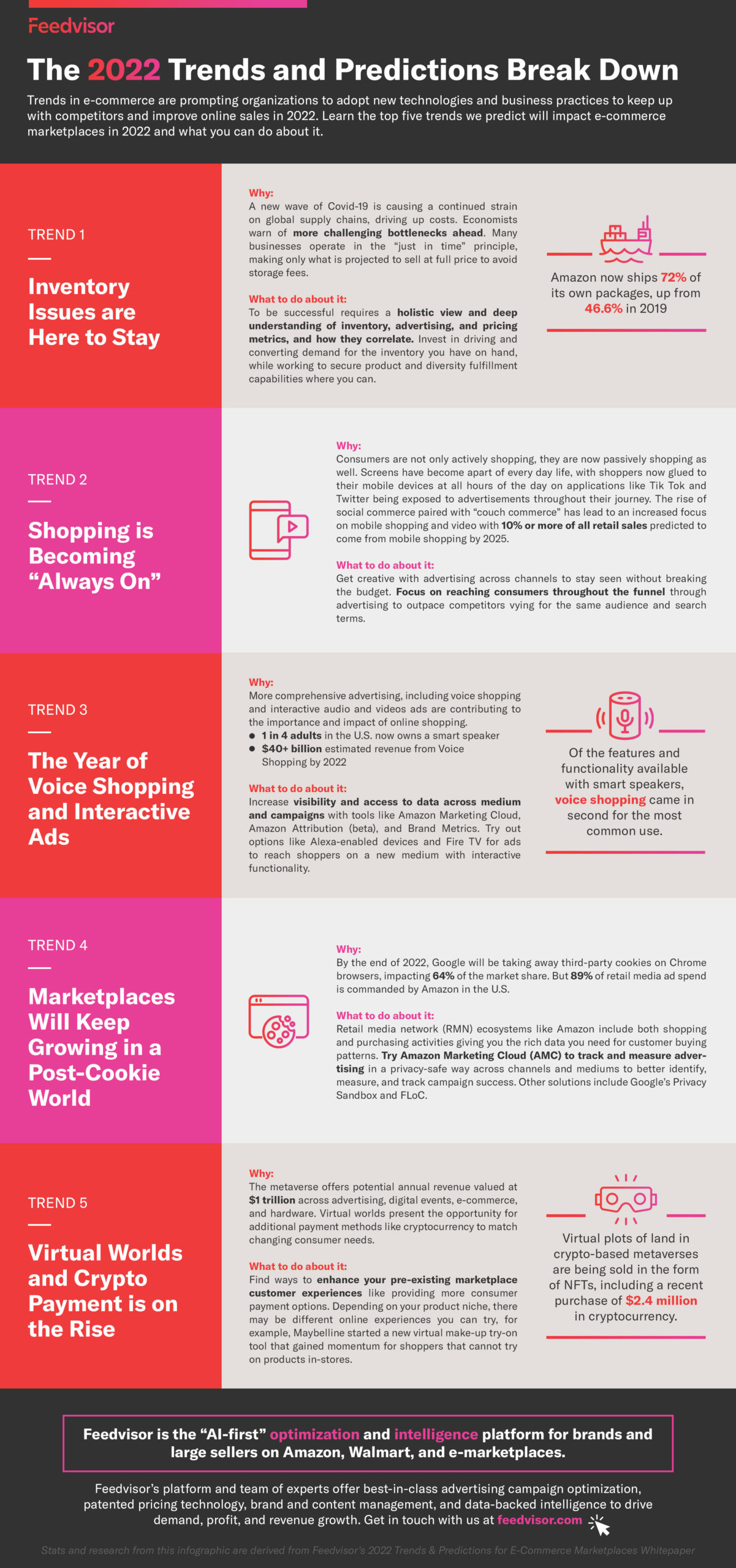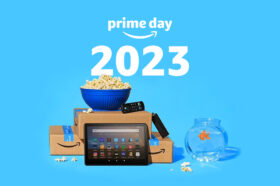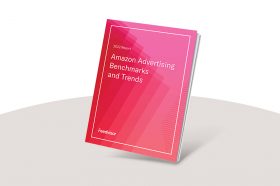Resources - Blog
A Look Back at 5 Predictions for the Future of E-Commerce in 2022

As another year comes to a close, we’re analyzing the 2022 predictions we got right and which didn’t quite pan out. Plus, learn how you can be the first to read our 2023 e-commerce predictions.
As the New Year inches closer, we thought we would take the opportunity to revisit the 2022 predictions we made last year around this time to see what we correctly predicted what we got wrong; and you’ll even get a chance to sign up to be the first to read our 2023 e-commerce trends and predictions.
2022 Predictions: What We Got Right (& Wrong)
At the beginning of each year, many writers and organizations publish a list of predictions, but we noticed that few care to check whether their predictions actually come true. To stay accountable, we looked back at our 2022 predictions to see which predictions we got right and which didn’t quite pan out.
Here are the predictions that we made at the start of 2022:

Retailers began to experience the opposite of what appeared to plague 2021 brands and sellers, too much product that wasn’t moving quickly enough.
Prediction 1: Inventory Issues are Here to Stay
A year ago, we predicted that inventory issues were not going away and would extend into all of 2022 as inflation became a growing concern.
We call our prediction a moderate success. Although inventory challenges seemed to be returning to “normal” near the middle of the year, retailers began to experience the opposite of what appeared to plague 2021 brands and sellers, too much product that wasn’t moving quickly enough. This excess inventory is one reason for the deep discounts that were seen even before the start of Cyber 5 near the end of October at retailers like Target, Walmart, and Amazon.

Although this greatly impacts sellers, according to Feedvisor data, supply chain disruptions are lessening in the eyes of consumers. Stating they are seeing an improvement in inventory, 89% of consumers say product availability has only sometimes or rarely been an issue.
While consumer interest in some categories has increased, inventory can remain high. For example, a household generally only purchases a new TV every two to three years. If inventory predictions were acted on the assumption of continued growth in the TV category, although there was an increase in interest, sellers might still have high excess inventory.
New reports suggest that the general supply chain is in the best position it has been since the beginning of the pandemic. Still, like usual, there is always a rise in challenges during the holiday season for many retailers throughout Q4.
Unfortunately, ongoing inventory issues are trending to last well into 2023, despite a strong Cyber 5 sales period. Understanding actual supply and demand is tricky, and complex technology like AI can be necessary to consider all factors influencing purchase decisions.
Feedvisor aggregates billions of data points in real-time, including advertising data, with a powerful and fast algorithmic repricer that responds to dynamic market conditions to fuel growth.
Almost half of all Cyber 5 sales this year made on mobile.
Prediction 2: Shopping is Becoming “Always On”
In 2021, we saw the beginning of “always on” shoppers, leading to the rise in “couch commerce,” or shopping from your mobile device while on the couch.
This prediction was a great success! Data from Thanksgiving day shopping shows that mobile shopping accounted for 55% of online retail sales, according to Adobe. That’s an increase of over 8% year over year, with almost half of all Cyber 5 sales this year made on mobile, reaching a mobile shopping record (44% of all online sales).
Online experiences are getting better and more consumers trust the security of transactions made on their mobile devices. According to Feedvisor’s proprietary data, 60% of consumers purchase on mobile and prefer mobile to buy products.
Mobile shopping is predicted to continue to grow in the next couple of years, which means brands and sellers need to continue to improve their mobile experience on Amazon, their own e-commerce site, as well as on social media and advertising across channels. One way we have seen mobile consumer experience improvements is through customized payments like Buy Now, Pay Later (BNPL) methods seen on high-traffic retailers like Amazon and Target. BNPL jumped 78% the week of November 19, 2022, compared to the previous week and is trending upward year over year, expected to increase U.S. spending per user by 13.5%.
The digital video market is showing marked acceleration and now accounts for nearly 40% of all display spend in Europe.
Prediction 3: The Year of Voice Shopping and Interactive Ads
This prediction was, in part, a success, but not how it was initially predicted.
We predicted this to be the year of voice shopping and interactive ads. Over half of the consumer journey now includes ads, and there is a growing importance to finding ways to stand out and become involved in different mediums and channels.
Although voice shopping is still a massive area of growth, it is important to note that the Amazon Alexa device, Echo, is not where most of this voice shopping and interactive ads are seeing growth. Amazon has decreased their investments in the smart speaker with mass layoffs to the Echo smart speaker and Alexa teams. Instead, they are focusing on a digital assistant and other “smart” products with many of the same features, plus new improvements.
Consumers using smartphones (age 18 to 24) have a mobile ad attention span of just 1.3 seconds, while the average for those 55+ is 2.1 seconds. The only exception to this is through more engaging ad experiences with a focus on immersive and interactive advertising.
Interactive ads continue to see the best results compared to other ad types because the interactive aspects of the ads draw attention to consumers, like being able to click through a carousel, play a game within an ad, or have moving elements in the ad. Within the interactive ad category, videos are the most popular. Consumers spend 34 seconds interacting with an ad that includes video, compared to just 1-2 seconds on static ads. The digital video market is showing marked acceleration and now accounts for nearly 40% of all display spend in Europe.
Interactive ads, especially video, will continue to grow as more brands, sellers, and advertisers implement video into their advertising.
Amazon has even introduced a Video Builder (beta) for Sponsored Brand Video placements, making it even easier for those that advertise with Amazon to create videos quickly.
Sign up for our newsletter to get our 2023 Trends & Predictions report in your inbox
Amazon marketplace sales are expected to grow by 15.3% in 2022
Prediction 4: Marketplaces Will Keep Growing in a Post-Cookie World
At the beginning of 2022, we knew that although upcoming third-party cookie data was being taken away, online marketplaces would continue to grow, if not more, due to their access and the greater importance of first-party data. Marketplaces continue to grow even as third-party cookies continue to be phased out across the web. This prediction was correct!
Across online marketplaces, we are seeing growth:
- Amazon marketplace sales are expected to grow by 15.3% in 2022
- Walmart Inc. is expected to see sales grow by 14.6% in 2022
- Target e-commerce U.S. sales are expected to grow 22.3% in 2022
- Shopify’s total retail e-commerce GMV is expected to grow by 21.5% in 2022
Although Google originally announced that third-party cookies would be phased out in 2021, recent announcements indicate that third-party cookies will not be completely phased out until the end of 2023. Agencies, in particular, are worried about this phaseout, but e-commerce powerhouses like Amazon have nothing to worry about.
Online marketplaces like Amazon have robust tracking tools like Amazon Marketing Cloud and Brand Metrics. New tools are also in development, with Amazon, in particular, continuing to develop and launch more analytics and measurement tools like Amazon Ad tags, Contextual Targeting (beta), and Pre-Campaign Planning Tools.

Prediction 5: Virtual Worlds and Crypto Payment is on the Rise
In 2021, we predicted that brands would begin to capitalize on the opportunities virtual worlds present. This is trending upward, as we have seen many brands jumping on the metaverse bandwagon.
Most recently, we’ve seen Bloomingdale’s debut a virtual department store for the holidays, Gucci launched “Gucci Garden” in Roblox, and Nike worked with RTKFT Studios to build a range of NFT sportswear and launch “Nikeland” in the metaverse on Roblox.
Many brands started 2022 by trademarking applications for the metaverse or virtual goods, with over 5,000 trademark applications filed in the US in 2022, including Disney, who has started to file patents for virtual simulators for a VR space in their theme parks. We even saw Macy’s host a Thanksgiving Day parade not only on the streets of New York but also in the metaverse. Though, it seems that brand interest in the metaverse is slowing down, as trademark applications have been slowing down throughout the year.
We call this prediction a moderate success. Although there is a greater adoption from brands in the metaverse, AR, NFTs, and crypto space, a variety of public failures and recent developments with crypto, NFTs, and the metaverse are leading some to not believe in the bright future that was promised during their rise to success.
There is still a way to go with consumer acceptance and adoption across platforms. Because of this public opinion, Amazon and other online marketplaces are not ready to accept crypto or Bitcoin as payment yet.
Final Thoughts
If the post-cookie world is frightening to you and your business on Amazon, or you want to start testing more video advertising, now is the time to research and test different tools that will give you the data that you will be missing without third-party cookies.
Feedvisor’s connected dashboards combine your data in Amazon with real-time market conditions, providing you with real-time and continuous optimizations. Let Feedvisor360 help you drive profitable growth on Amazon business while giving you the insights you need to make crucial decisions.
Feedvisor is offering a 14-day free trial, so you can experience the “AI-first” integrated platform that optimizes your advertising and repricing on Amazon.



